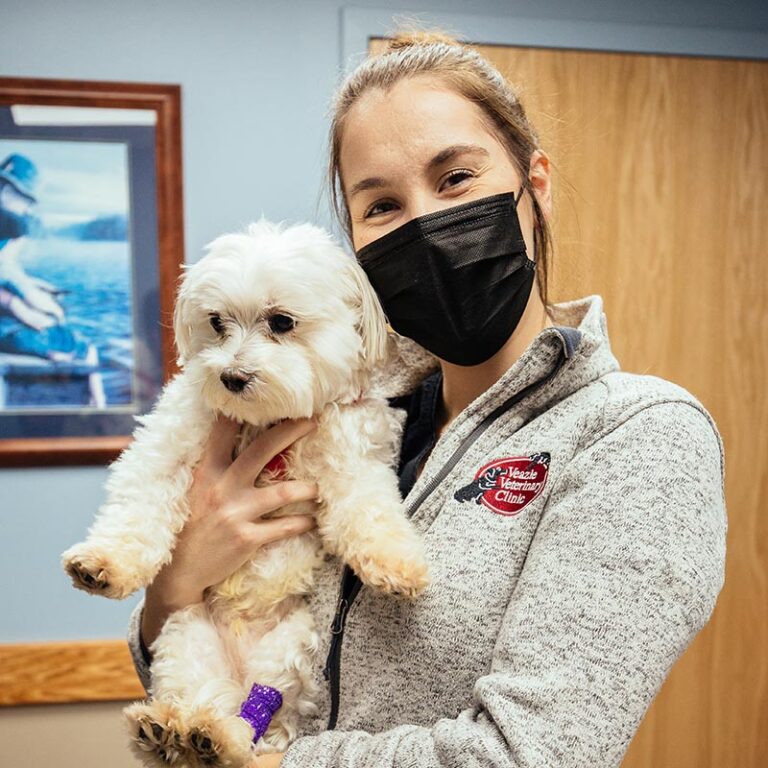WE RECOMMEND SPAYING AND NEUTERING PETS AS EARLY AS 6-8 MONTHS OLD ONCE THEY HAVE FULLY UNDERGONE THEIR PUPPY OR KITTEN VACCINATIONS.
The primary reason you should have your pet spayed or neutered early on is that female dogs and cats can begin their heat cycles as early as seven months and males can develop aggressive behaviors during puppyhood or kittenhood. Large breed dogs, in most cases, are recommended to wait until 12 months of age.
What Does Spay and Neuter Really Mean?
Spay and neuter surgeries are a humane method of dog and cat sterilization. Neutering simply means “to remove reproductive organs.” In males the specific term is castration, and the testicles are removed from inside the scrotum. In females the term used is spay, and traditionally the ovaries and uterus are removed in a procedure called an ovariohysterectomy.
In 2018, we added laparoscopic equipment and are now performing laparoscopic spays on all dogs over 15-20 pounds. Our spays are now a surgery called an ovariectomy, which only removes the ovaries; the uterus remains behind. The benefit of this procedure is that it is much less invasive, and only requires three small (approximately 1”) incisions instead of being a full open abdomen surgery like most traditional ovariohysterectomy spays. Female dogs recover much quicker and have much less discomfort after this procedure. There is no risk of pregnancy after this type of spay, as the ovaries are the organs which contain the eggs and hormones required for pregnancy.
Cats and small dogs (under 15-20 pounds) still undergo an ovariectomy but their surgery is not done with the laparoscope.
Benefits of Spaying and Neutering
There are several important benefits of spaying and neutering dogs and cats, which we outline below.
Spaying Eliminates the Heat Cycle
Female dogs and cats will go through their routine heat cycle if they are not spayed. Heat cycles can be uncomfortable for your pet and cause them to attract the attention of male dogs or cats in the vicinity. Eliminating the heat cycle prevents these issues and makes life easier for your pet and for you.
Improves Behavior
Neutering will not change a pet’s personality, but it can prevent, or limit, behaviors fueled by testosterone. Male dogs and cats that remain intact tend to be more aggressive, territorial, and destructive, and may engage in frequent spraying, roaming, and mounting behaviors.
Helps to Reduce Animal Homelessness and Overpopulation
One of the most important aspects of spay and neuter surgeries is their ability to help curb animal overpopulation and homelessness. With millions of dogs and cats ending up in shelters every year, it is inevitable that many will face euthanasia due to overcrowding. Preventing unwanted litters can help shelters find homes for more pets, reducing animal homelessness.
Better Health for Pets
Dog and cat “fixing” is also better for your pet’s health. First, it reduces or prevents a pet’s chances of escaping the home and roaming in search of a mate, which could put them in harm’s way. Additionally, and perhaps more important, spay and neuter surgery can reduce the likelihood for certain types of cancer, such as mammary cancer and prostate issues, and prevent other conditions, including pyometra (a potentially fatal uterine infection) and testicular cancer.
Preventing or reducing the risk of certain diseases can help your dog or cat live longer.

Common Myths About Spaying and Neutering
The Biggest Myth: It’s Too Expensive
“It is too expensive to neuter my pet.” It’s actually too expensive not to. An average puppy spay is priced less than the cost of caring for a litter of unwanted puppies or kittens. The care of an average litter of 6 puppies for basic care: deworming, vaccinations, examinations, other health screenings and pet food until they are 8 weeks old (the minimum age at which they can be released to new owners) is estimated at about $350 per puppy. This cost is assuming there is no difficulty during birth requiring a c-section and that the puppies are both healthy and do not need any specialized care.
These costs do not include lost work and gas for veterinarian visits, bowls, leashes, collars, damage from chewing and house soiling, care of the mother during pregnancy and advertising to place the litter. It also doesn’t include the costs if there are complications with labor or delivery that require a caesarian-section.
Multiply this by just 1 litter per year over several years and the one time ‘expense’ doesn’t even come close to the reality of caring for multiple litters over the life of the mother. And of course there are the expenses associated with diagnosing and treating any disease they may develop that could have been prevented had they been neutered such as uterine infections or testicular cancer.
There are many programs through the state, local humane societies and shelters that can assist with the cost of neutering.
A female should have a litter before she is spayed
Females should be spayed before their first heat. This prevents uterine infections, decreases the incidences of mammary cancer and keeps another litter of unwanted animals out of the local Humane Society or shelter. We recommend spaying between 4 and 6 months of age.
I want my children to see a birth
Animals often hide during the birthing process. They don’t want an audience any more than you would. There are many ways for children to see the miracle of birth without putting the family pet through this painful and possibly dangerous experience. Foster a shelter animal that is already pregnant, watch a DVD or visit a farm. Remember birth is about life, not the lesson that it is okay to dispose of living things after you get the experience.
My pet’s temperament will change
If you have an older animal, it has already learned its behavior; it will still be as loving or as aloof as it always was. If you neuter early enough you may avoid behaviors such as spraying, roaming, fighting and mounting.
Males don’t need to be neutered because they don’t have litters
First there are the behavioral issues. Neutered males don’t roam, fight, mark their territories, or “hump” as much. Second is the health issues—neutered males that don’t fight are less likely to get bite wounds and abscesses. They don’t develop testicular cancer. They are less likely to develop prostate issues. And third, let’s just be good neighbors and not get the next door neighbor’s female pregnant or they may be asking “What’s in your wallet?”
I can find good homes for a litter
If this were true there would be no animals in shelters. There aren’t enough good homes out there. Don’t contribute by making more unwanted litters.
My dog is a purebred
Purebred dogs end up in shelters, too. The Humane Society of the United States estimates that approximately 25% of dogs in shelters are purebred. To properly breed a purebred dog requires researching the proper mate based on personality, conformity, and genetic history, testing for eye issues and screening for hip issues to prevent inheritable diseases such as dysplasia. The “profit” from breeding dogs is eaten up by basic good breeding standards.
More Things to Consider:
Females: An unspayed female will bleed when she is in heat. That means blood stains everywhere she is in your house that will need to be cleaned and treated. Keeping your female away from all the unneutered males in the neighborhood for weeks on end. Even if she’s inside they will gather and try to find a way to her and her to them. While in heat the obnoxious behavior of whining and crying will be unending. Female cats are known to be especially obnoxious. Many cat owners have called thinking their cat is in pain (or even dying!) because of the howling, crying and generally crazy behavior the owner is witnessing.
Males: A neutered male will still develop their masculine appearance. Castration does not affect their ability to be watchdogs. A good watchdog is the result of good training. It also does not affect their ability to hunt and will allow them to be around other dogs because there is less chance of inter-male aggression. For cats this means less likelihood of marking. It will also prevent the distinctive (and offensive) male cat body odor. Intact males also roam, go missing for days and get into fights over females.
Please Neuter
We cannot emphasize enough the importance of neutering your pets. We want all pets to have good, long, healthy lives. This simple and relatively inexpensive, one-time, preventative step will make for a much happier life for you and your pet and keep more animals out of the already overflowing shelters and prevent unwanted euthanasia.


